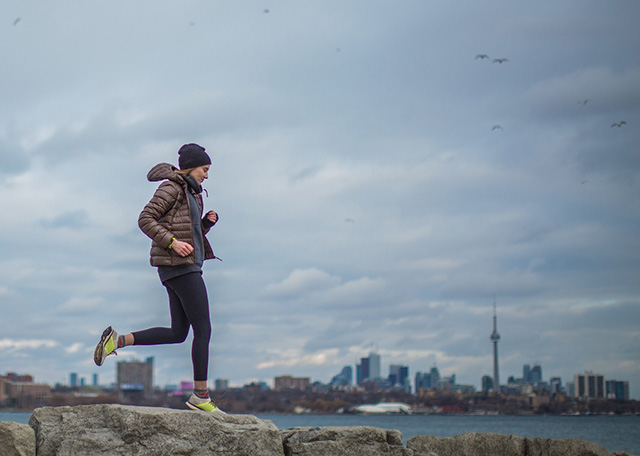Arctic-like temperatures and hazard winter conditions scourge the U.S and North America at times. Such reports demand special attention of outdoor fitness enthusiasts.
Injuries due to overexposure in cold temperature have risen in recent years due to increased participation in outdoor winter activities such as ice skating, skiing, snowboarding, and in all-season walking, jogging, and cycling. Short of relocating to Hawaii and taking up surfing, knowledge of potential hazards and prevention during cold weather is the key to keeping us safe during our outdoor fitness activities.
 cold weather workout
cold weather workoutCold-Weather Risks
The biggest dangers in cold weather include frostbite and hypothermia.
Frostbite is a cold-related injury characterized by the actual freezing of tissue. The hands and feet are affected most frequently, although cheeks, nose, ears and even corneas may be involved. Greatest at risk are those over-exposed in cold environments, including solders, the homeless, and yes ... winter and high-altitude fitness enthusiasts. Early warning signs include tingling and numbness in the fingers and toes or burning sensations in the nose and ears. Frostbite is no picnic; damaged tissue needs to be surgically removed and often does not regenerate.
Hypothermia is the decrease in core body temperature to a level at which normal muscular and cerebral functions are impaired. Typically occurring in temperatures below freezing, hypothermia can be present even in 60-degree weather for some populations. Conditions leading to hypothermia include improper clothing and equipment, wetness, dehydration and fatigue.
Signs and symptoms are numerous. In mild to moderate hypothermia these may include involuntary shivering, inability to complete complex motor functions (like walking or talking) slurred speech, or irrational behavior. Severe hypothermia is immediately life-threatening and indicated when core temperature falls to 92 degrees. Pulse rate decreases, pupils dilate and muscle rigidity develops due to reduced peripheral blood flow.
Dressing To Prevent Cold-Injury
Heat conservation is the major goal when exercising in cold climates. Prevent heat loss by wearing appropriate clothing. The key to protection is to wear clothing that is layered, lightweight and waterproof or water-resistant.
Insulation is provided by the air trapped between clothing fibers and the skin, which becomes warm and provides a barrier to heat loss. The more layers between the skin and the air, the more insulation. Several layers of lighter provide better protection than a single bulky layer.
For the innermost layer against the skin, choose a lightweight synthetic such as polypropylene. This wicks moisture away from the body's surface and dries quickly. Cotton or natural fibers tend to become saturated and stay wet. Clothing that becomes wet through sweating or external moisture loses almost 90% of its insulating properties. Since water conducts heat 25 times faster than air, wearing wet clothing will quickly facilitate heat loss.
Lighter sweaters and long-sleeve shirts made with natural materials work best as inner layers, providing insulation without restricting movement.
Cover these layers with a zipped or easy to open jacket. Choose one that is both waterproof and lightweight, since it will be your protection from snow, rain and wind, and will be the layer you shed if you heat up too quickly.
Since 30 to 40% of body heat dissipates through our heads, top off your ensemble with a hat, or helmet, depending on your sport. Make sure to cover your ears. Since hands/fingers are highly susceptible to frostbite, wear mittens or gloves.
Don't forget the wind-chill.
Used by the National Weather Service since 1973 as a public health tool to reduce cold injuries, the wind-chill index represents the cooling effect of the wind on bare skin for different temperatures and wind velocities. Higher winds increase the cooling effect of cold temperatures, further emphasizing the need to cover skin in cold weather.
Interestingly, the wind-chill effect will vary not only depending on wind velocity, but on the speed of the exerciser in relation to wind velocity. For example, jogging 8 mph into a 10-mph headwind creates the equivalent of 18-mph wind speed. Conversely, jogging 8-mph with a 10-mph at one's back reduces the relative wind speed to only 2-mph. Even more reason to be aware of the day's index and plan accordingly.
Other considerations
Terrain can become problematic during cold weather. Ice can make surfaces particularly hazardous and snow can block visibility. Be knowledgeable of the terrain; stick to commonly run jogging paths. Ski or snowboard on hills on which you have experience.
Streets or sidewalks that have not been cleared can easily hide potholes, debris or slick patches of ice that can cause a twisted ankle or knee. Best to train where snow cover is minimal. If the weather conditions are extremely cold, windy and snowy, go to the gym or work out at home.
Hydration and Nutrition
Due to the dry environment usually present in cold weather, hydration is extremely important. Significant body fluid can be lost and since sweat may evaporate more quickly than in a hot environment, you may not have a clear indication of how much fluid you are actually losing. Always begin your workout properly hydrated and continue drinking 15 to 20 ounces of water per hour.
For long workout sessions, keep high-energy snack foods available. Energy bars and packaged fruit/nut mixes are easy to carry and make for high carbohydrate snacks. Fill a thermos with hot foods like soups or chili and you prevent straying off your eating schedule.
The recent rash of severe winter weather across North America may be uncomfortable, but if you're a winter workout warrior, it shouldn't interfere with your outdoor workouts. Use common sense and preparation to keep your winter workouts both safe and effective.
Related Pages
- Athelete Nutrition When Traveling to a Cold Climate
- Exercise in Extreme Conditions — articles and information
- Tips for Safe Outdoor Workouts
- Exercising safely in heat
Disclaimer


 Current Events
Current Events